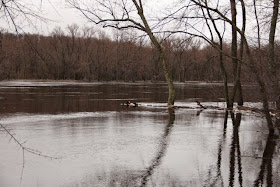Near the base of the nested places that we call home is the Sunrise River watershed, which is tributary to the St. Croix River. According to the Minnesota Pollution Control Agency, much of the water in the Sunrise River and the lakes in the watershed fails to meet appropriate water quality standards. This, in turn, means that "The Sunrise River was identified as one of the greatest contributors of phosphorus and sediment to the St. Croix River (U.S. Geological Survey, 1999)." That surprised me, as did the number of registered feed lots in the watershed.
manure management needed?
Photo by J. Harrington
I've lived in this area for a long while. Before moving to Minnesota, I became involved in environmental planning and management back when the 1972 Clean Water Act Amendments were being considered by Congress. Because of work I've been involved with over the years, I was not surprised to see that "BMP effectiveness monitoring is currently not being done widespread due to funding. There are not many funding opportunities to encourage this type of practice on the local level." (BMPs are Best Management Practices for non-point sources of pollution such as agricultural and urban runoff.) The largest reduction in a critical pollutant, phosphorus, is expected to be attained with the implementation of agricultural conservation tillage practices. The watershed has some folks who follow conservation practices, but, judging by the amount of snirt we saw in ditches last Winter, there's lots of room for improvement. I wonder if "snirt counts" could be a way to track improvements.
crop residue in the field
Photo by J. Harrington
We've been fussing and fuming for some time now about the fact that agriculture is largely exempt from water quality pollution reduction requirements. We've also expressed a lot of scepticism about whether a voluntary approach is likely to be successful. After all, if we Minnesotans were sufficiently inclined to follow "best practices" like obeying the speed limit, we wouldn't need as many traffic cops as we have. So, since many of the issues, concerns and opportunities we've written about (e.g., Minnesota River sediment reductions) are going on right in our back yard, so to speak, we're now commited to focusing on learning more about the local actors, actions and results, and writing about what we learn, during the next year or so, God willing and the river don't rise, to borrow a phrase that would be most helpful in Texas these days.
Spring high water, St. Croix River
Photo by J. Harrington
A River
God knows the law of life is death,and you can feel it in your warbler neck,your river-quick high stick wristat the end of day. But the trophies:a goldfinch tearing up a pink thistle,a magpie dipping her wing tipsin a white cloud, an ouzel barrelinghip-high upstream with a warning.You wish you had a river. To makea river, it takes some mountains.Some rain to watershed. You wishyou had a steady meadow and pink thistlesbobbing at the border for your horizons,pale robins bouncing their good posturesin the spruce shadows. Instead, the lawof life comes for you like three menand a car. In your dreams, you win them overwith your dreams: a goldfinch tearing upa pink thistle. A magpie so slowshe knows how to keep death at bay,she takes her time with argumentand hides her royal blue in black.Shy as a blue grouse, nevertheless Goddoesn’t forget his green mountains.You wish you had a river.
********************************************
Thanks for visiting. Come again when you can.
Please be kind to each other while you can.



No comments:
Post a Comment